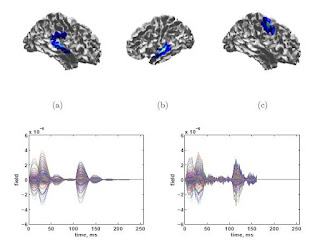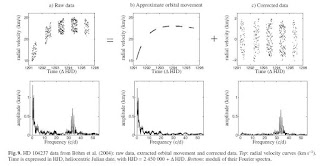
* EEGs are notoriously known for ill-posed problems. Andrew Bolstad, Barry Van Veen and Robert Nowak take a stab at Space-Time Sparse Reconstruction for Magneto-/Electroencephalography. The abstract reads:
This article presents a new spatio-temporal method for M/EEG source reconstruction based on the assumption that only a small number of events, localized in space and/or time, are responsible for the measured signal. Each space-time event is represented using a basis function expansion which re°ects the most relevant (or measurable) features of the signal. The basis function expansion effectively models sources which span local regions of cortex and occupy specific frequency bands and/or time windows. This model of neural activity leads naturally to a Bayesian likelihood function which balances the model fit to the data with the complexity of the model, where the complexity is related to the number of included events. A novel Expectation-Maximization algorithm which maximizes the likelihood function is presented. The new method is shown to be effective on several MEG simulations of neurological activity as well as data from a self-paced finger tapping experiment.One wonders if a compressed sensing implementation could then be simply implemented using Open Source EEG and the addition rule presented in Sensor Networks.

* In Astronomy, the CLEAN and the CLEANEST algorithms are known to not be optimal but are the best tools available so far. Sebastien Bourguignon, Hervé Carfantan and Torsten Böhm tried to improve on this current algorithms by using sparsity in SparSpec : a new method for fitting multiple sinusoids with irregularly sampled data, the abstract reads:
Context. The location of pure frequencies in the spectrum of an irregularly sampled time series is an important topic in astrophysical data analysis. Especially in the domain of asteroseismology, a highly precise and unambiguous study of frequencies in photometric light or radial velocity curves is required.
Aims. Due to sampling irregularities and large observational gaps, the classic methods for frequency estimation (prewhitening techniques, clean, cleanest, etc.) sometimes suffer false detections. We propose a new framework for this problem that allows a more
precise and unambiguous frequency location.
Methods. Multisine fitting is addressed as the sparse representation of the data in an overcomplete dictionary of frequencies, hence the name SparSpec for the method. We model the data as the sum of an arbitrarily large number of pure frequencies, discretised on a fixed grid. Among all the many representations fitting the data, we seek the one with the fewest non-zero amplitudes. This solution can be computed by minimising a convex criterion with no local minima. A computationally efficient and convergent optimisation strategy is derived and a user-friendly software implementing SparSpec is provided online at http://www.ast.obs-mip.fr/Softwares.
Results. The method is first illustrated on a simple test example where SparSpec correctly locates the frequencies while classic methods fail. Then, simulations on more realistic artificial time series reveal the interest of this new methodology in terms of robustness toward sampling aliases. An application to the radial velocity curve of the pre-main sequence Herbig Ae star HD104237 is finally presented, where the method is able to determine oscillation frequencies even in the presence of strong low-frequency perturbations such as orbital movements. While SparSpec mainly confirms previously published studies for the four more important frequencies, it suggests some ambiguity about the position of a fifth frequency. Additional simulations show that the SparSpec results are more plausible.
What are the signs that you could be scatter brained ? you are drowning in a collision of acronyms: This time it is STS - space-time sparse, Space Transportation System, Superior Temporal Sulcus.
No comments:
Post a Comment